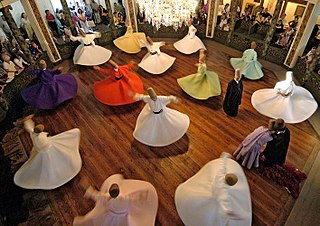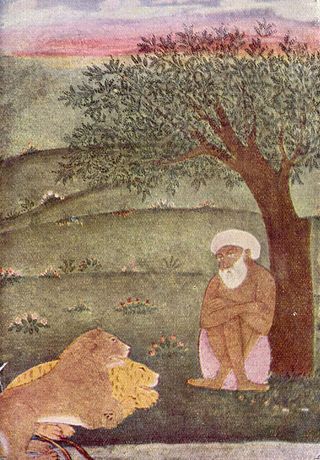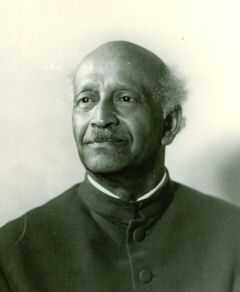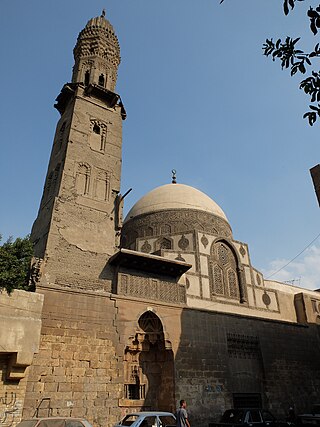Related Research Articles

Sufism, also known as Tasawwuf, is a mystic body of religious practice, found mainly within Sunni Islam but also within Shia Islam, which is characterized by a focus on Islamic spirituality, ritualism, asceticism and esotericism. It has been variously defined as "Islamic mysticism", "the mystical expression of Islamic faith", "the inward dimension of Islam", "the phenomenon of mysticism within Islam", the "main manifestation and the most important and central crystallization" of mystical practice in Islam, and "the interiorization and intensification of Islamic faith and practice".
Sama or SAMA may refer to:

The Chishtī Order is a tariqa, an order or school within the mystic Sufi tradition of Sunni Islam. The Chishti Order is known for its emphasis on love, tolerance, and openness. It began with Abu Ishaq Shami in Chisht, a small town near Herat, Afghanistan about 930 AD.

Sama is a Sufi ceremony performed as part of the meditation and prayer practice dhikr. Sama means "listening", while dhikr means "remembrance". These performances often include singing, playing instruments, dancing, recitation of poetry and prayers, wearing symbolic attire, and other rituals. Sama is a particularly popular form of worship in Sufism.

Dervish, Darvesh, or Darwīsh in Islam can refer broadly to members of a Sufi fraternity (tariqah), or more narrowly to a religious mendicant, who chose or accepted material poverty. The latter usage is found particularly in Persian and Turkish (derviş) as well as in Amazigh (Aderwish), corresponding to the Arabic term faqīr. Their focus is on the universal values of love and service, deserting the illusions of ego (nafs) to reach God. In most Sufi orders, a dervish is known to practice dhikr through physical exertions or religious practices to attain the ecstatic trance to reach God. Their most popular practice is Sama, which is associated with the 13th-century mystic Rumi. In folklore and with adherents of Sufism, dervishes are often credited with the ability to perform miracles and ascribed supernatural powers. Historically, the term Dervish has also been used more loosely, as the designation of various Islamic political movements or military entities.

Qawwali is a form of Sufi Islamic devotional singing, originating in South Asia.

Sufi whirling is a form of physically active meditation which originated among certain Sufi groups, and which is still practiced by the Sufi Dervishes of the Mevlevi order and other orders such as the Rifa'i-Marufi. It is a customary meditation practice performed within the sema, or worship ceremony, through which dervishes aim to reach the source of all perfection, or dharma. This is sought through abandoning one's nafs, ego or personal desires, by listening to the music, focusing on God, and spinning one's body in repetitive circles, which has been seen as a symbolic imitation of planets in the Solar System orbiting the sun.

Islamic music may refer to religious music, as performed in Islamic public services or private devotions, or more generally to musical traditions of the Muslim world. The heartland of Islam is the Middle East, North Africa, the Horn of Africa, West Africa, Iran, Central Asia, and South Asia. Due to Islam being a multi-ethnic religion, the musical expression of its adherents is vastly diverse. Indigenous traditions of various part have influenced the musical styles popular among Muslims today. The word "music" in Arabic, the language of Islam, is defined more narrowly than in English or some other languages, and "its concept" was at least originally "reserved for secular art music; separate names and concepts belonged to folk songs and to religious chants".)

Divan-i Kebir, also known as Divan i Shams, is a collection of poems written by the Persian poet and Sufi mystic Mawlānā Jalāl-ad-Dīn Muhammad Balkhī, also known as Rumi. A compilation of lyric poems written in the Persian language, it contains more than 40,000 verses and over 3,000 ghazals. While following the long tradition of Sufi poetry as well as the traditional metrical conventions of ghazals, the poems in the Divan showcase Rumi’s unique, trance-like poetic style. Written in the aftermath of the disappearance of Rumi’s beloved spiritual teacher, Shams-i Tabrizi, the Divan is dedicated to Shams and contains many verses praising him and lamenting his disappearance. Although not a didactic work, the Divan still explores deep philosophical themes, particularly those of love and longing.

Quṭb al-Aqṭāb Khwājā Sayyid Muḥammad Bakhtiyār al-Ḥusaynī, Quṭb al-Dīn Bakhtiyār Kākī was a Sunni Muslim Sufi mystic, saint and scholar of the Chishti Order from Delhi, India. He was the disciple and the spiritual successor of Mu'in al-Din Chishti as head of the Chishti order, and the person to whom the Qutb Minar, Delhi is dedicated. Before him the Chishti order in India was confined to Ajmer and Nagaur. He played a major role in establishing the order securely in Delhi. His dargah located adjacent to Zafar Mahal in Mehrauli, and the oldest dargah in Delhi, is also the venue of his annual Urs festivities. The Urs was held in high regard by many rulers of Delhi like Qutb ud-Din Aibak, Iltutmish who built a nearby stepwell, Gandhak ki Baoli for him, Sher Shah Suri who built a grand gateway, Bahadur Shah I who built the Moti Masjid mosque nearby and Farrukhsiyar who added a marble screen and a mosque.

A khanqah or khangah, also known as a ribat (رباط), is a building designed specifically for gatherings of a Sufi brotherhood or tariqa and is a place for spiritual practice and religious education. The khanqah is typically a large structure with a central hall and smaller rooms on either side. Traditionally, the kahnqah was state-sponsored housing for Sufis. Their primary function is to provide them with a space to practice social lives of asceticism. Buildings intended for public services, such as hospitals, kitchens, and lodging, are often attached to them. Khanqahs were funded by Ayyubid sultans in Syria, Zangid sultans in Egypt, and Delhi sultans in India in return for Sufi support of their regimes.
Dynamic meditation is a form of meditation in which physical actions are involved. The term appears in the early 1970s when Osho's descriptions of his "Rajneesh Dhyan Yoga," developed at meditation camps in the Indian mountains, were translated into English. His prototypical method is still named "Dynamic Meditation."

Musharaff Moulamia Khan was born in Baroda (India) on 6 September 1895 and died in The Hague (Netherlands) on 30 November 1967. Не was the youngest brother of Inayat Khan, and shared his delight in music. While in his teens he had just come to Calcutta to study and be under the influence of his brother when Inayat was called away to America, and Musharaff was left alone. Within a year, however, he also journeyed to the west, where he joined Inayat and became one of 'The Royal Musicians of Hindustan.'
Sama'i is a vocal piece of Ottoman Turkish music composed in 6/8 meter. This form and meter is often confused with the completely different Saz Semaisi, an instrumental form consisting of three to four sections, in 10/8 meter, or usul aksak semai. Semai is one of the most important forms in Ottoman Turkish Sufi music.
A wasla is a set of pieces in Arabic music. It comprises eight or more movements such as muwashshah, taqsim, layali, mawwal, qasida, dawr, sama'i, bashraf, dulab, and popular songs.

Ahmad Ghazālī was a Sunni Muslim Persian Sufi mystic, writer, preacher and the head of Al-Nizamiyya of Baghdad. He is best known in the history of Islam for his ideas on love and the meaning of love, expressed primarily in the book Sawāneḥ.

Abu-al-Hasan Ali ben Abdallah al-Nuymari as-Shushtari or Al-Sustari was an Andalusian-Arab Sufi Sheikh, philosopher, jurist, and poet. He is best known by posterity for his poetry, which was designed to be sung in songs employing simple monorhymes to praise God with everyday musical idiom, which won wide recognition beyond the hundreds of disciples in his own Shushtariyya brotherhood.

Fanna-Fi-Allah is a Canadian–American group which plays Qawwali, a form of Sufi devotional music popular in South Asia.

The Maizbhandari, or sometimes Maijbhandari, order or tariqa of Sufism within Sunni Islam was founded in the late 19th century by the Bengali Sufi saint Ahmad Ullah Maizbhandari. It is the only Sufi order to have originated from within Bengal, and, as a movement, it has continued to enjoy significant popularity in the 21st century.

The Madrasa of Amir Sunqur Sa'di, also commonly known as the Mausoleum of (Sheikh) Hasan Sadaqa, is a medieval Mamluk-era madrasa structure and mausoleum in Cairo, Egypt. It was originally built between 1315 and 1321 CE by amir Sunqur Sa'di. Sunqur was forced to leave Egypt in his lifetime and was never buried there, but a sheikh known as Hasan Sadaqa was later buried in it and therefore the building is often known by his name. From the 17th century onward the complex was converted into Mevlevi Sufi lodge and is open today as the Mawlawiyya Museum or Museo Mevlevi.
References
- ↑ Gribetz, Arthur (1991). "The Samā' Controversy: Sufi vs. Legalist". Studia Islamica. 74: 43–62. JSTOR. doi:10.2307/1595896. JSTOR 1595896.
